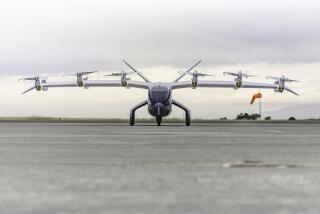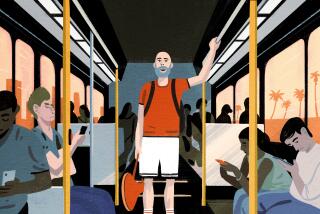Small Bus Operators Try to Revive Old Routes
Armando Flores saw opportunity while driving a Greyhound bus last year.
A driversâ strike had forced the company to drastically cut service, and Flores, a replacement worker, said he believed that there were enough travelers for another carrier--his own.
âI thought there was potential in that business,â said Flores, a former truck driver who has won preliminary approval from regulators to run intercity bus service between the Imperial Valley, Los Angeles and San Diego.
Flores, however, is one of the few to see much promise in intercity bus service. Despite cutbacks in the Greyhound network over the years, few have bothered to fill the gap with new or expanded service, transportation experts say.
Thatâs particularly the case in California, where some entrepreneurs who recently entered the field have found it tough going. The cost of insurance, equipment--even a used bus costs $35,000--and government paperwork takes a toll on intercity operators.
âThere are not a lot people who are just waiting to rush into this,â said Robert Strauss, a senior transportation rate expert with the California Public Utilities Commission, which oversees intercity bus companies. âThe return (on investment) isnât there, and the bus is not a glamorous form of transportation in California.â
Despite the hurdles, new bus firms still try to make a go of it. Brothers Ali and Nasser Sabbah began Falcon Lines 2 1/2 months ago to run on a former Greyhound route between the coastal town of Ft. Bragg and the Bay Area.
Unlike the Greyhound schedule, Falcon Lines makes a daily round trip to San Francisco and Ft. Bragg. Costs are low: The Sabbah brothers are the drivers, and their two vans are much less expensive to operate than the 47-seat buses Greyhound used on the winding forest roads.
However, Falconâs insurance premiums alone run about $10,000 a year, and the payments on the vans proved costlier than expected. Meanwhile, weekly ticket sales fell from 100 a week during the summer to about 65 now.
âIt will take a lot work and and a lot of energy to keep this one running,â said Sabbah, a former snack food distributor. âIâm concerned about the revenues and how to increase them.â
In Central California, Mike Haworth, president of Orange Belt Stages and the third generation of his family to operate the company, wonders why anyone would even consider starting intercity service these days. His company did not expand service when Greyhound was struck.
âI would say it is not prudent to jump into the market,â said Haworth, whose bus company transports about 600,000 passengers annually between such towns as Bakersfield, Barstow and San Luis Obispo.
The Visalia-based company has experienced moderate growth in the charter business, while its intercity service, which began in the 1930s, has either stagnated or declined in recent years.
âWe have some mixed feelings,â Haworth said. âWe are certainly committed to our intercity passenger service. But we are a little leery that the ridership and revenue stats continue to dwindle.â
Flores, however, remains optimistic about his bus service, Royal Lines, which is expected to start service later this fall with a $25 one-way fare between the Imperial Valley and Los Angeles. The 32-year-old San Diego resident is negotiating to buy used buses and has struck agreements with fast-food outlets in the Imperial Valley to serve as bus stops.
Flores also plans to offer bus riders something that many have been denied in the past. âThey want some respect too.â
More to Read
Sign up for Essential California
The most important California stories and recommendations in your inbox every morning.
You may occasionally receive promotional content from the Los Angeles Times.










